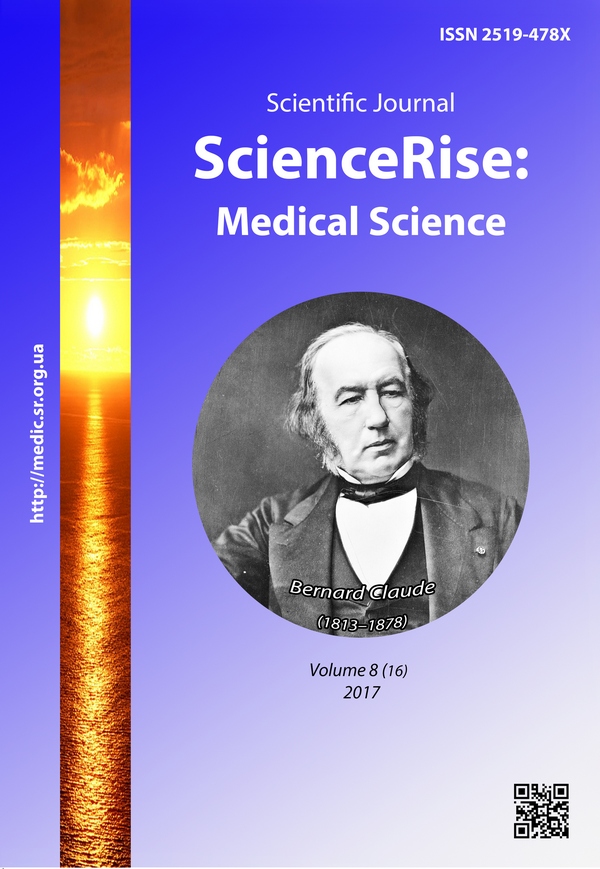Estimation of the psychoemotional state of parents of babies with a heavy craniocerebral trauma as a basis of the system of medical-psychological support in child's neuro-surgery
DOI:
https://doi.org/10.15587/2519-4798.2017.109176Keywords:
baby’s parents, craniocerebral trauma, emotional disorders, anxiety, depression, astheniaAbstract
Aim: The complex study of features of emotional disorders in parents of children of the first year of life with a heavy craniocerebral trauma.
Materials and methods. 137 families (mother and father) of children of the first year of life with craniocerebral trauma, examined and treated in a child’s neurosurgical department. The mean age of parents was 27,0±3,0 years.
Methods of examination: anamnestic, psychodiagnostic with questionnaires of neuropsychic tension (T.A. Nemchyn, 1984), clinical scales of anxiety and depression (M. Hamіlton, 1967),adapted to ICD-10 (G. P. Panteleev, 1988), scale of situational and personal anxiety by D. Spilberg (adapted by Y.L. Hanin, 1981).
Results of research. A child’s disease is a psychotraumatic situation for all parents and leads to the development of anxious-depressive reactions and statuses. The anxious-depressive, astheno-depressive, depressive-adaptive and dysphoric variants of emotional disorders in parents of babies with a heavy craniocerebral trauma were separated and their clinical features were described.
The high level of emotional tension, abrupt intensification of negative emotions, effect of sorrow and anxiety, depressive manifestations are typical for parents of babies with a craniocerebral trauma. According to the data of the psychodiagnostic examination in parents were observed a light moderate depressive and anxious episodes by Hamilton scale; high levels of situational and personal anxiety by C.D. Spilberg’s method, high level of expressiveness of nervous-psychic tension by T.A. Nemchyn scale.
Conclusions. The high level of emotional tension, abrupt intensification of negative emotions, anxious-depressive manifestations were typical for parents after a baby’s craniocerebral heavy trauma
References
- Polinder, S., Haagsma, J. A., van Klaveren, D., Steyerberg, E. W., van Beeck, E. F. (2015). Health-related quality of life after TBI: a systematic review of study design, instruments, measurement properties, and outcome. Population Health Metrics, 13 (1). doi: 10.1186/s12963-015-0037-1
- Von Steinbuechel, N., Covic, A., Polinder, S., Kohlmann, T., Cepulyte, U., Poinstingl, H. et. al. (2016). Assessment of Health-Related Quality of Life after TBI: Comparison of a Disease-Specific (QOLIBRI) with a Generic (SF-36) Instrument. Behavioural Neurology, 2016, 1–14. doi: 10.1155/2016/7928014
- Valiullina, S. A., Promyslova, S. A., Tyutyukina, A. I. et. al. (2014). Children craniocerebral trauma: epidemiology and basic principles of the organization of medical care. Moscow, 24.
- Kvasnitskiy, M. V. (2013). Diagnostics and prescription of the first medical aid in cases of craniocerebral trauma. Medicine of Urgent Conditions, 3 (50), 34–38.
- Kazakov, V. Ye. (2014). Immune disorders as harbingers of the unfavorable course of craniocerebral trauma. Ukrainian Journal of Psychoneurology, 22 (1 (78)), 129–131.
- Wang, H.-C., Yang, T.-M., Lin, Y.-J., Chen, W.-F., Ho, J.-T., Lin, Y.-T. et. al. (2014). Serial Serum Leukocyte Apoptosis Levels as Predictors of Outcome in Acute Traumatic Brain Injury. BioMed Research International, 2014, 1–11. doi: 10.1155/2014/720870
- Markova, M. V., Vetrila, T. G. (2010). About the development of a complex system of medical and psychological rehabilitation of families raising a child with a violation of mental development. Ukrainian Journal of Psychoneurology, 18 (3 (64)), 28–32.
- Markova, M. V., Piontkovskaya, O. V. (2013). Functionality of the family system as a factor of the prevention of mental health disorders in parents of children with cancer pathology. International Neurological Journal, 4 (58), 49–53.
- Piontkovskaya, O. V. (2013). Behavioral Patterns to Overcome Stress in Parents of Oncologic Children. Journal of Psychiatry and Medical Psychology, 1 (32), 80–83.
- Kuzhel, I. R. (2010). Assessment of the level of stress and severity of psychopathological symptoms among members of the family of incurable oncological patients. Medical Psychology, 5 (4), 50–59.
- Piontkovskaya, O. V. (2013). The state of mental health of parents of children with oncological pathology. Ukrainian Bulletin of Psychoneurology, 21 (1 (74)), 90–94.
- Vetril, T. G. (2009). The state of mental health of family members, in which grows a child with a disability of mental development. Arkhiv psikhiatrіi, 15 (2 (57)), 47–51.
- Zavgorodnya, N. I. (2014). Mechanism of formation and clinical features of adaptation disorders in women who gave birth to a premature infant. Experimental and Clinical Medicine, 1 (62), 131–136.
Downloads
Published
How to Cite
Issue
Section
License
Copyright (c) 2017 Oleksandr Dukhovskyy

This work is licensed under a Creative Commons Attribution 4.0 International License.
Our journal abides by the Creative Commons CC BY copyright rights and permissions for open access journals.
Authors, who are published in this journal, agree to the following conditions:
1. The authors reserve the right to authorship of the work and pass the first publication right of this work to the journal under the terms of a Creative Commons CC BY, which allows others to freely distribute the published research with the obligatory reference to the authors of the original work and the first publication of the work in this journal.
2. The authors have the right to conclude separate supplement agreements that relate to non-exclusive work distribution in the form in which it has been published by the journal (for example, to upload the work to the online storage of the journal or publish it as part of a monograph), provided that the reference to the first publication of the work in this journal is included.









